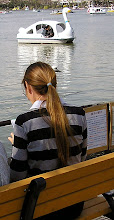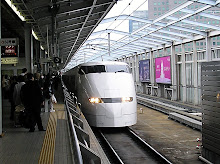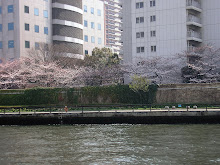 Rikishi (Sumo wrestlers) performing the ring entering ceremony, Osaka 2008
Rikishi (Sumo wrestlers) performing the ring entering ceremony, Osaka 2008With the arrival of new carriers, eg Jetstar, bringing competition to the market and cheaper fares, many people who’ve always wanted to go to Japan are now taking the plunge. For the first time traveller who hasn’t a clue about travelling in Japan, but would like a good taste of the sights and experiences, I’ve tried to put together a few pointers to get you started. If you have already been to these places and fancy somewhere new, skip to the end for some information I’ve gathered after two holidays spent entirely down south on the island of Kyushu.
WHEN TO GO
Tourists arrive year round in Japan, but most would agree it’s best to avoid Golden Week (last days of April, first week of May) when a number of public holidays fall close together and transport/accommodation is booked solid, usually with surcharges. Also the Obon festival (mid July or mid August depending on the area) sees lots of Japanese returning to their home towns.
If you are into skiing, winter is a great time to visit, if not, perhaps avoid it as some mountain bus services and tourist areas close for months, and the very cold weather makes it difficult to travel light. Similarly, Japan’s wet season /summer around June -July is not for those who dislike heat and humidity.
My favourite times in Japan are Spring and Autumn. If you are lucky you will catch sakura , cherry blossom season, late March, early April, depending on the weather and locality. There are websites which predict the start of sakura each year in the various parts of Japan - the warmer areas bloom first, and the cooler areas last. Similarly, in Autumn the leaves on trees turn colour and some people think it more beautiful than cherry blossom time.

WHAT TO SEE
Most people when they think of Japan think of things like Mt Fuji, Bullet trains, sumo wrestlers, samurai warriors, tatami mats and sushi. Even if you can’t experience all of these in a typical 10 -14 day visit to Japan, you will still come home feeling you’ve had a good taste of Japanese life and culture provided you are prepared to get out and about on your own. Such everyday experiences as wandering the basement food halls of big department stores, riding the local trains and subways, freeloading with everyone else in the book stores, walking past noisy pachinko parlours and dodging the hundreds of bikes and riders on the footpaths - it’s all a window onto the way ordinary Japanese go about their lives.
If you do have your heart set on the iconic :
Mt Fuji - first, all those pictures you see are taken on the very rare days when the air is clear and the clouds are not around. Generally, you can get very close and have no idea where the thing is, even though it’s huge. I’ve stood on Mt Fuji and haven’t been able to see it, the fog was so bad. On a clear day you can actually see it from tall buildings in Tokyo, or out of the window of the Bullet train passing by on the way to Kyoto. If you want to get closer there are bus tours from Tokyo which actually take you up the mountain and you can walk around at the fifth station, which is quite high. Or you can buy the Odakyu Railway (not JR) Hakone “Free Pass”, which is valid for either 2 or 3 days http://www.odakyu.jp/english/ , and either depart from Shinjuku in Tokyo, or pick up the train in Odawara, south of Tokyo, which you can reach by Shinkansen (Bullet train) using the JR pass. The “Free Pass” entitles you to use the zigzag train, cable car, ropeway, pirate ship across Lake Ashi, and bus back to Odawara, as you do a circuit around the Mt Fuji National Park. If Mt Fuji is not hiding, the view from the cable car and lake is amazing.
For a fuller description of a day trip around the park using the Odakyu pass, see the final entry to this blog.
 Lake Ashi, Mt Fuji National Park
Lake Ashi, Mt Fuji National ParkBullet trains - the Shinkansen is quite expensive, but if you intend to venture afield from where your plane lands in Japan, there are various JR rail passes that you can buy which entitle you to ride most of the Shinkansens, with free seat reservations. The pass can also be used on some JR buses, local or rapid JR trains, and the JR ferry across to Miyajima island to see the famous floating red torii (Shrine gates), near Hiroshima.
http://www.japanrail.com/index.php?page=JR-japan-rail-pass
To decide if a JR pass is value for your particular itinerary, visit the Hyperdia website http://www.hyperdia.com/classic_en/hyperWeb.cgi to find travel times and fares. The classic version of Hyperdia is much more user friendly than the newer one. Note that the base fare and surcharge must be added together to get the fare for a Shinkansen ticket. If you are having difficulty with destination names etc, the next link has useful information on using Hyperdia properly. http://www.japanrail.com/index.php?page=JR-hyperdia

Sumo wrestlers - there are six grand sumo tournaments held each year. They are in the odd numbered months, 3 are in Tokyo, with one each in Osaka (March), Nagoya (July), Fukuoka (November). http://www.sumo.or.jp/eng/ticket/nittei_hyo/index.html They run for 15 days, starting on a Sunday. Reserved seating is hard to get if you aren’t already in Japan and can’t speak Japanese, but every morning about 400 cheaper (Y2000 approx) unreserved seats go on sale at the door for that day’s matches, one ticket per customer. In March 2009 we were offered seats in all but one category of seating on the morning of the match, though this was the first Monday and was not well attended. If you happen to be in a city when a tournament is on, you should go. The matches start early, but the better ones begin about 3pm, and the best at 4pm, by which time seats are very hard to find. Otherwise, you can try to visit a sumo “stable” to watch early morning training, though this would require a bit of research.
 Sumo Grand Champion (Yokozuna) Hakuho
Sumo Grand Champion (Yokozuna) Hakuho
Samurai warriors- Japanese feudal castles are everywhere, the trick is to find one that is not a ferro-concrete reproduction. Many castles were destroyed by the Japanese themselves during civil war, and others, like the one at Hiroshima, were destroyed or damaged by Allied Bombs in WW2. But even the repro ones are good to visit, the insides are usually museums, with displays of samurai armour, weapons etc. One of the best originals is at Himeji (undergoing lengthy restoration work starting late 2009)- and it’s easy to get to if you are staying near Osaka, Kyoto or Hiroshima. Another little gem is at Hikone (not Hakone), near Lake Biwa, an easy outing from Kyoto. Osaka castle (a repro) is very impressive, right in the heart of the city, and easily accessed on the JR Loop line if you have the rail pass, or the subway. Osaka Castle
Osaka Castle
Tatami mats - you will really know you are in Japan if you spend a night or two in a ryokan - a traditional inn. These can cost a fortune, but there are some really nice ones that are the same price as a mid range hotel. Lots have English web sites, find a name and google it up. The fun starts from the moment you step inside the door and have to exchange your shoes for slippers.
People often ask if futons on the floor are too hard for sleeping - I’ve found mattresses in Japan are generally very firm anyway, and the futon on springy tatami mats in some cases is a bit softer. Futons on tatami, Rickshaw Inn, Takayama
Futons on tatami, Rickshaw Inn, Takayama
Sushi - Japan is the land of the convenience store -kombini. Prices are not a rip off, and shelves are restocked frequently. When you buy food and drink, you will automatically receive straws, disposable chop sticks, whatever, plus there are usually microwaves and hot water dispensers so you can prepare your dinner or noodle cup before leaving the store if you want. Most also stock beer at competitive prices, and some even have bottles of wine. Apart from the sushi and rice balls, there’s lots of bakery items (savoury and sweet). The Japanese have their own take on these things - that bread roll won’t be plain, it will have something injected inside - butter and jam, chocolate filling, sweet bean paste, banana butter…, if you are too shy to ask, enjoy the surprise. Similarly, that bottle of chocolate milk/iced coffee might be cold milk tea. Just fill your basket, line up and pay - you can always see the total on the cash register even if you can’t understand the language.
IS JAPAN REALLY EXPENSIVE?
If you book into a big western hotel chain and eat your meals in their dining room, only to venture out on organised tours, then yes, Japan can be very expensive. However, use the internet to find cheaper hotels, eat with the locals, and strike out on your own with maps and advice from tourist information offices, and you will find things are equal to, if not a good bit cheaper, than at home. For example:
*Stay in the Toyoko Inn chain hotels http://www.toyoko-inn.com/eng/ - a twin room with breakfast included is under Y9000 for 2 people. (about $90 early 2008) The compact but spotless rooms have private bathroom, TV, water boiler, green tea, cups, (unstocked) fridge, free internet, hairdryer and free toiletries. (Coin laundries downstairs as well, and good maps to locate the hotel on the website.)

*Eat in restaurant arcades (often near stations) for lunch - a set menu with main course, rice, soup/salad and free iced water/green tea will be around Y1000, ($10) and most have plastic replicas of meals outside and/or picture menus which you can show the waitress. A main meal on its own eg katsudon (tender sliced crumbed pork cutlet on a deep bed of vegetable rice with egg) is usually under Y700,($7) and is very filling.

*Buy supplies from supermarkets or convenience stores, prices are reasonable.
*Drink alcohol from supermarkets/convenience stores/vending machines back in your room, rather than in bars (many of which have seating charges and other hidden expenses.)
*Bring a mug and a box of teabags or jar of coffee from home. Fresh milk is available in convenience stores, and most places have either a water boiler in your room or down the hall near the beer vending machine, or they will give you a thermos of boiling water on request. Likewise there is usually a fridge in your room or a communal fridge close by. If you like a cuppa, check these details when booking accommodation.
*Look out for travel passes or combined entry tickets to attractions.
 A wedding party outside Himeji castle.
A wedding party outside Himeji castle.
PLANNING AN ITINERARY
 Map from HGM2005 Travel Information
Map from HGM2005 Travel Information
Some airlines (eg JAL and Jetstar) allow you to enter Japan through one port and leave from another at no extra cost. The usual is arrival in Tokyo, departure from Kansai airport (near Osaka). This allows a straightforward itinerary with minimal backtracking. In the past JAL also allowed us to fly onto any other major city in Japan after arrival in Tokyo for free- we chose Fukuoka.
Whatever my flights, I always buy at least one rail pass voucher before departure to Japan, and plan an itinerary that sees all of my long distance legs covered by the pass. I usually spend 3 nights or so in the city of arrival, using local trains and subways to get around, then activate the pass for a long journey to another city. I try to get value out of the pass for its duration, before settling in for the last nights of my holiday close to my city of departure.
If you have to use Kansai (Osaka) airport but prefer to stay in Kyoto, but your pass has already expired at the end of your holiday, or you don’t want to activate yet at the start because you plan to see all the local sights by bus for a couple of days, you can purchase another pass as well. The one day JR west Kansai area pass for Y2000 is valid for the Haruka airport express service, between Kansai airport and Kyoto, unreserved seating. This is a considerable saving, and the pass can also be used on that day for other JR local or rapid trains, eg for a trip to Nara. http://www.westjr.co.jp/english/global.html



7 comments:
I'll be flying from China to Fukuoka next week to do a visa run and decided that I'd like to just hang out in Japan for anything from a couple of weeks to a few months. I currently do not have a ticket out of Japan and so will get one while in Japan - i.e. could be from any city.
I've never been to Japan before but am NOT interested in tourist sights (natural or man-made). However, I would like to hang out in places normal people hang out in etc (could be a city or the countryside, whatever) to get a feeling for the culture etc.
I'm currently learning Chinese and plan to continue while in Japan since I have plenty of self-study material - so there is no danger of getting bored.
Any advice, would be much appreciated thanks!?
I must say this post serves as an excellent tourist guide especially for the first timer. I love the pics that u have put up. Would love to ride the bullet train sometime..
Birth Certificate
Hi--thanks for your succinct overview of Japan.....funny how some blogs do it better than big travel sites, jeesh.
I have a unique question:
I am in search for a sincere, compassionate culture to live in while I teach English abroad for a year.
I am native American, and very turned off by what I (used to think was uniquely) American 1) selfishness and 2) shallowness.
I think Americans are really only interested in how good looking and how wealthy other people are. Also, American culture is very individualistic, and I feel like there is little camaraderie among people.
I studied abroad in Nicosia, Cyprus, and found much of the same--it seemed very ''wannabe'' American, materialistic, narcissistic.
I am considering Japan to live in.
How would you rate Japanese people's caring about other people, and valuing ideas and humor over just good looks/money?
Thanks in advance for your insights on this different type of question. I'm excited to hear your opinions.
reading this blog make me feel... I must visit Japan some day...
Wow, this blog is extremely helpful! Especially as a first time venturer to Japan, great guide! Covers all espects of travelling, thank youu!
I found this helpful too, check it out :)
http://www.hotelmanagementtutorial.com/category/seven-star-hotel-in-world
This has some great information on travelling to Japan. I went back in 2005 and fell in love with this country.
I stumbled over here different website and thought I should check things out. I like what I see so now im following you. Look forward to exploring your web page yet again.
What’s happening in Tokyo
Post a Comment